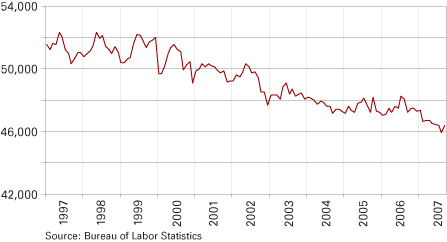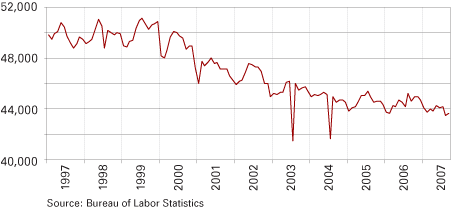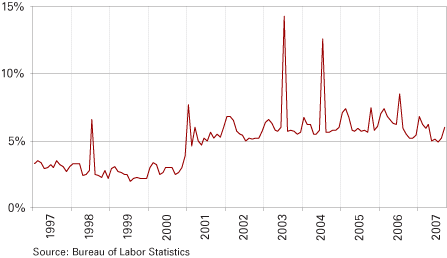Kokomo
Professor of Economics, Director of the Center for Economic Education, Indiana University Kokomo
As noted in the forecasts for the international, national, and state economies, the recovery is okay (but not great), we expect growth to be okay (but not great), and employment numbers look okay (but certainly not great). However, the Kokomo economy, while improving, continues to lag behind the nation and state.
Kokomo's economy remains heavily weighted toward manufacturing. Employment in manufacturing industries peaked statewide in June 2000 and, while recent losses have been much less than before and some months have even posted gains, employment has still not regained anywhere close to its peak. The labor force is smaller than it was in 1997 (which can be a blessing—if it were the same size and employment had not increased, then the unemployment numbers would look even worse). Figures 1 through 3 illustrate Kokomo's employment picture and are courtesy of the U.S. Department of Labor website. (1)
Figure 1
Kokomo MSA Labor Force

Figure 2
Kokomo MSA Employment

Figure 3
Kokomo MSA Unemployment Rate

Therefore, like the rest of the state, individuals and firms in the area remain apprehensive about the economy and what it holds for them personally. This area remains heavily invested in industrial production and is very subject to economic disruptions with changes in industrial production. The really important news is that many of these job losses will be permanent due to increasing productivity, job losses to overseas, the troubles in the automobile industry, etc. This means that manufacturing production, while increasing somewhat, is unlikely to return to the glory days of the past. To put this in perspective, the Kokomo Metropolitan Statistical Area (MSA) has seen manufacturing and government jobs each decrease by 1.3 percent in the past twelve months. The only sector with increased employment was the trade, transportation, and utilities sector with a 1.4 percent increase. Overall employment figures dropped by 0.2 percent. The total number and percent of jobs are decreasing; the high-wage manufacturing jobs are really decreasing; and the growth areas of this economy are small (i.e., almost nonexistent) and may not pay as high of a wage as the manufacturing jobs.
As a result, even if job growth is occurring, it is not in the same high-paid industries that drove the Kokomo economy for so long. This has an impact on stores and restaurants as the buying habits of workers making $800 per week may not be equivalent to those earning $1,640 per week. Economic theory says that the lower paid workers may dine out less, buy less clothing (or buy clothing at less expensive stores), travel less, and buy less expensive electronics (all of those goods being what economic theory calls “normal goods”). So retailers, restaurateurs, and others need to be aware of these trends and plan accordingly.
There are some bright spots—agriculture continues to perform reasonably well. The 10-31 land swaps (2) have put quite a few dollars into the local economies as land has changed hands, and $4 corn makes commodity farmers very happy (it doesn't make the livestock farmers nearly as happy). There are new businesses starting in the area, and Indiana, as noted in the state report, has had some success in attracting new large business operations to Indiana.
Overall, growth for the Kokomo economy is questionable. Trends in the automobile and other manufacturing industries will need to be watched carefully, and local authorities (of schools, government, etc.) will need to remain proactive on preparing their stakeholders for the future. In particular, students in K-12 will need to be reminded that their futures lie in industries very different from those of their parents and that they need to acquire the skills needed for their future.
Notes
- Data are available at http://data.bls.gov/PDQ/servlet/SurveyOutputServlet?series_id=LAUMT18290206&data_tool= percent22EaG percent22.
- More technical information on like-kind property exchanges is available from the IRS.
Also in this Issue…
- Outlook for 2008
- The International Economy
- The U.S. Economy
- Financial Forecast
- Housing
- Indiana Agriculture
- Indiana
- Anderson
- Bloomington
- Columbus
- Evansville
- Fort Wayne
- Gary
- Indianapolis-Carmel
- Kokomo
- Louisville
- Muncie
- Richmond
- South Bend-Mishawaka and Elkhart-Goshen
- Terre Haute
- Return to Table of Contents



